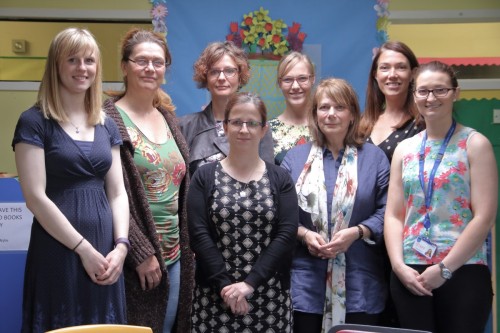Archived
Please note, this page may contain outdated information or subject matter.
A focus on assessing the vision of children in special educational settings will, Professor Kathryn Saunders hopes, lead to better visual health and classroom engagement…

Professor Saunders (third from left) with colleagues (left to right) Ms Emma McConnell, Professor Karola Dillenburger-Keenan,
Dr Julie McClelland, Ms Shelley Black, Dr Lynne McKerr, Dr Julie–Anne Little, and Ms Louise Stirrup.
Pamela Anketell and Jonathan Jackson are also part of the research team.
What inspired you to investigate this particular area?
I’ve always been interested in the amazing way in which the human baby’s brain and eyes ‘learn’ to see – from the really rather poor visual function that tiny babies typically have, to the excellent vision that most children take for granted. With all the complex and intricate processes that need to mature in just the right way in order for this to happen, it is incredible that so many do have good vision and normal visual processing. However, because the brain and nervous system is so important for good vision and visual function, children with developmental disabilities are more likely to have vision problems. As an optometrist and a researcher I was interested in finding out more about this – particularly so that improved knowledge of vision and visual disorders in developmental disability could lead to better assessment, treatment and habilitation.
What does Action funding for this study mean to you?
We are really grateful to Action Medical Research for funding this research. It is a great opportunity to undertake a detailed investigation of how children in special education settings see and how they use their eyes and vision in the classroom. We will also find out whether provision of in-school vision assessment improves both visual health and classroom engagement for those who had previously unidentified visual issues.
What does a typical day look like for you … or is every day different?
I’m really fortunate to work in an environment where I do different things all the time and have great colleagues, students and patients who motivate and challenge me each day. Some days I’m testing eyes, some days I’m teaching undergraduate optometry students or postgraduate optometrists and some days I’m doing research – brainstorming with colleagues and research students about new projects and new ideas, analysing and writing up research findings or collecting data out in schools or in the laboratory. I’m always juggling a long ‘to do’ list, but I’m certainly never bored.
Can you tell us a bit about your team?
Ulster University Vision Science Research Group has a strong history of paediatric vision research and my colleagues Julie McClelland and Julie-Anne Little are central to that work. They are both passionate optometrists, academics and researchers with lots of experience of working with children with special needs. Karola and Lynne from Queens University’s School of Education have worked together for years, particularly in the area of autistic spectrum disorders and behaviour. This is the first time we have collaborated on a project and we are really excited about the expertise they bring. Emma McConnell and Shelley Black are both optometrists who are relatively new to the research environment, but they have lots of fresh new ideas and enthusiasm and extensive clinical skills.
Who’s your research hero, and why?
My research hero has to be my PhD supervisor, Maggie Woodhouse. A PhD supervisor is an important person in any researcher’s career and I’ve been lucky to maintain a connection with her after my PhD and to continue to learn from her over the years. Maggie is a clever researcher, a nit-picking editor and good fun. This is an ideal combination for a PhD supervisor in my eyes! Just as importantly, her research has led to improvements in clinical eye care for children with Down syndrome and better ways of assessing young children and older patients with communication difficulties. I aspire to have as much impact.
As a charity, Action began in 1952 with our founder’s quest to find a cure for polio. What led you to a career in medical research?
Curiosity, and an offer of a PhD studentship from the College of Optometrists. I fell into research but I haven’t regretted it for a moment.
Action’s loyal and lovable mascot Paddington Bear™ is very fond of marmalade sandwiches. What’s your favourite snack?
Nuts. And anything with marmite. Someone needs to market Marmite coated cashew nuts – that would be perfect.
Tell us something that will surprise us!
I have webbed toes! I have a newspaper phobia – I hate the smell of them and find it uncomfortable to be in the same room as a bundle of Sunday papers. I also have a three-legged dog. I’m full of surprises!

Find out more...
You can find out more about Professor Saunders’ work here, and read a blog by Dr Maggie Woodhouse OBE, who is also currently working on an Action funded study, here. You might also find Henry’s story interesting.
